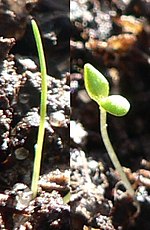In biology, phototropism is the growth of an organism in response to a light stimulus. Phototropism is most often observed in plants, but can also occur...
17 KB (2,027 words) - 18:50, 4 April 2024
fields Phototropism: movement or growth in response to lights or colors of light Aphototropism: negative phototropism Skototropism: negative phototropism of...
8 KB (783 words) - 20:13, 28 September 2024
This is called phototropism. Janoudi and his fellow coworkers wanted to see what type of phytochrome was responsible for causing phototropism to occur, and...
22 KB (2,831 words) - 15:37, 20 September 2024
(1832). It was renamed phototropism in 1892, because it is a response to light rather than to the sun, and because the phototropism of algae in lab studies...
10 KB (1,242 words) - 20:14, 28 September 2024
of fungus in the Zygomycota phylum. They are known for their strong phototropism response and helical growth of the sporangium. The best studied species...
3 KB (377 words) - 09:10, 13 June 2024
by motion; for example, the leaves of a plant turning toward the sun (phototropism), and chemotaxis. Interaction between organisms. the processes by which...
3 KB (330 words) - 14:09, 15 May 2024
Zygomycota (section Phototropism)
These specialized hyphae usually show negative gravitropism and positive phototropism allowing good spore dispersal. The sporangia wall is thin and is easily...
29 KB (3,400 words) - 14:22, 20 May 2024
light. This is known as positive phototropism. The roots grow away from light. This is known as negative phototropism. Monocytes and macrophages of the...
14 KB (1,628 words) - 23:29, 26 September 2024
mature, gravitropism continues to guide growth and development along with phototropism. While amyloplasts continue to guide plants in the right direction, plant...
23 KB (2,786 words) - 23:24, 15 November 2024
ISBN 978-1-260-01935-3. OCLC 1034587285. Whippo CW, Hangarter RP (May 2006). "Phototropism: bending towards enlightenment". The Plant Cell. 18 (5): 1110–9. doi:10...
40 KB (4,214 words) - 20:12, 18 August 2024
Cryptochrome (section Phototropism)
several loops and few beta sheets. In plants, cryptochromes mediate phototropism, or directional growth toward a light source, in response to blue light...
59 KB (6,478 words) - 20:52, 2 October 2024
occur via a plant's response to a particular stimulus, such as light (phototropism), gravity (gravitropism), water, (hydrotropism), and physical contact...
26 KB (3,267 words) - 18:45, 18 October 2024
Panama. The seeds fall to the ground, then the seedlings crawl (negative phototropism) until they meet a tree on which to attach. The many adjacent roots thus...
16 KB (1,891 words) - 15:22, 12 October 2024
his father on experiments dealing with plant movements, specifically phototropism. They co-authored The Power of Movement in Plants (1880) and Francis...
10 KB (1,015 words) - 16:29, 12 June 2024
third day of the germination (if in the darkness). Early experiments on phototropism using coleoptiles suggested that plants grow towards light because plant...
8 KB (967 words) - 22:35, 15 July 2024
include the climbing vines of Araceae (Alismatales) which use negative phototropism (skototropism) to locate host trees (i.e. the darkest area), while some...
116 KB (11,177 words) - 00:34, 12 November 2024
organisms, or the motion of the leaves of a plant turning toward the sun (phototropism), and chemotaxis. Reproduction: the ability to produce new individual...
107 KB (10,463 words) - 04:14, 12 November 2024
photoreceptor proteins (more specifically, flavoproteins) that mediate phototropism responses across many species of algae, fungi and higher plants. Phototropins...
9 KB (1,031 words) - 01:59, 20 June 2024
251–265. doi:10.1002/bio.955. PMID 17285566. Sivinski, J. M. (1998). "Phototropism, bioluminescence, and the Diptera". Florida Entomologist. 81 (3): 282–292...
9 KB (906 words) - 22:36, 4 November 2024
directionalization of organs- for example, stems turning toward light sources (phototropism), roots growing in response to gravity (gravitropism), and other tropisms...
46 KB (5,289 words) - 12:10, 10 November 2024
black plastic, or other material to eliminate the effects of negative phototropism. The nutrient solution is changed either on a schedule, such as once...
91 KB (9,388 words) - 18:50, 20 November 2024
particularly phototropism. He identified riboflavin and other flavins as what are called phototropins, photoreceptor proteins for phototropism (the bending...
32 KB (3,189 words) - 23:48, 25 October 2024
monocotyledons, including the tendencies for the shoot to grow towards the light (phototropism) and the roots to grow downward (gravitropism). In both cases the directional...
9 KB (1,227 words) - 20:00, 4 December 2023
property of oil rejection Photophobia (biology) a negative phototaxis or phototropism response, or a tendency to stay out of the light Ultrahydrophobicity...
47 KB (2,884 words) - 23:22, 5 November 2024
to the discovery of a novel red-light sensing mechanism involved in phototropism of flowering plants. Kiss also was one of the first scientists to study...
17 KB (1,358 words) - 15:31, 16 September 2024
Phycomyces research has focused on sporangiophore photobiology, such as phototropism and photomecism ('light growth response'). Metabolic, developmental,...
5 KB (529 words) - 00:38, 11 January 2024
The Power of Movement in Plants is a book by Charles Darwin on phototropism and other types of movement in plants. This book continues his work in producing...
7 KB (1,009 words) - 23:24, 20 July 2024
the common tropisms seen in plants is phototropism, the bending of the plant toward a source of light. Phototropism allows the plant to maximize light exposure...
30 KB (3,553 words) - 20:52, 18 May 2024
detectable change in the plant's environment. As a result, the plant exhibits a reaction of phototropism—directional growth (2.) toward the light stimulus....
30 KB (3,960 words) - 22:51, 21 September 2024
conditions. Photophobia (or photophobic response) may also refer to a negative phototaxis or phototropism response. What are sciophytes? - Times of India v t e...
830 bytes (68 words) - 04:39, 4 July 2023




















